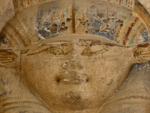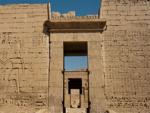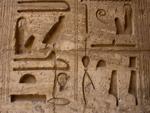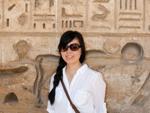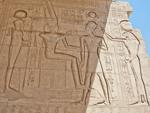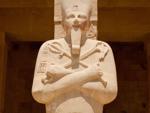Across the Nile is the world famous Valley of the Kings housing Tomb of Tutankhamun, however, the more impressive and little known are the associated Funerary Temples and Tombs of the Nobles.
I initially thought we could walk the site the whole day; after all it was only two kilometres from the hotel. We started our journey towards the ferry crossing, and were followed by a taxi driver who tried to convince us to hire his taxi, we politely declined. We caught the 1 EGP ferry and continued up the road. The same taxi driver drove up alongside us and offered to take us to the ticket office for 2 EGP, and eventually we accepted. After some discussion, he had made business, we arranged 80 EGP for 8 hours of taxi hire, quite a bargain, I thought.
The following were the tickets we purchased that day (and this didn’t even include the Valley of the Kings!)
- Temple of Deir El-Madina (30 EGP)
- Medinet Habu Temple (30 EGP)
- Ramesseum Temple (30 EGP)
- Deir el-Bahari Temple (inc. Hatshepsut’s Temple) (30 EGP)
- Temple of Seti I (30 EGP)
- Tombs of the Nobles
- Tomb of Userhat and Tomb of Khaemhet (25 EGP)
- Tomb of Rekhmire and Tomb of Sennofer (25 EGP)
- Tomb of Menna and Tomb of Nakht (25 EGP)
thydzikgooglemap(http://sonyaandtravis.com/maps/egypt-2011-luxor-west-bank.xml,s)
Temple of Deir El-Median
Deir El-Median was a village home to Egyptian artisans that worked on the tombs in the Valley of the Kings. One of the main features in the temple dedicated goddess Hathor. When drawn from the front Hathor has a very distinguishable wide face with pointy ears.
thydzikgooglemap(http://sonyaandtravis.com/maps/egypt-2011-luxor-temple-of-deir-el-median.xml,s)
Medinet Habu Temple (Mortuary Temple of Ramesses III)
We entered through the Migdol Gate which brought us to the magnificent first pylon with decorated walls of Ramesses III defeating the Nubians and Syrians. Inside the first court are statues of Ramesses III as Osiris. Throughout the complex the walls were covered in amazing carvings and hieroglyphs, many with vibrant colours.
thydzikgooglemap(http://sonyaandtravis.com/maps/egypt-2011-luxor-medinet-habu-temple.xml,s)
Ramesseum Temple
The Ramesseum is the memorial temple of famous Ramesses II. We entered the first court from the north; in front of the second pylon were the remains from a giant statue of Ramesses II. In the second court were eight statues of Ramesses II. Moving from the second court was the Great Hypostyle Hall, where once stood forty-eight columns with capitals of closed and open papyrus flowers.
thydzikgooglemap(http://sonyaandtravis.com/maps/egypt-2011-luxor-ramesseum-temple.xml,s)
Deir el-Bahari Temple and Hatshepsut’s Temple
One of the most amazing monuments is the mortuary temple of Queen Hatshepsut, hidden beneath and in the relief of cliffs known as Deir el-Bahari. Approaching from the ticketing-booth were small caves carved out of the valley’s cliff face, similar to what we had seen in Petra. Turning the valley corner you see an enormous cliff face with the Hatshepsut Temple sitting at the bottom, in the centre a cause-way leading all the way to the lower terrace of the temple. The ramp to the middle terrace was flanked by two statues of sitting god Horus. On the left side was Chapel of Hathor, bearing columns featuring the head of Hathor.
thydzikgooglemap(http://sonyaandtravis.com/maps/egypt-2011-luxor-hatshepsuts-temple.xml,s)
Temple of Seti I
As one would have guessed the temple of Seti I is the memorial temple of Pharaoh Seti I. Though the temple wasn’t very impressive, it now had lush palm trees interspersed throughout which was nice.
thydzikgooglemap(http://sonyaandtravis.com/maps/egypt-2011-luxor-temple-of-seti-i.xml,s)
Tombs of the Nobles
The Tombs of the Nobles are the burial tombs of priests and officials. While we were there we were the only tourists, however just as we left a tour bus of Egyptians arrived.
thydzikgooglemap(http://sonyaandtravis.com/maps/egypt-2011-luxor-tombs-of-the-nobles.xml,s)
Tomb of Userhat (TT56) and Tomb of Khaemhet (TT57)
Both tombs had beautiful paintings of daily Egyptian life, hunting, fishing and agriculture. In the Tomb of Userhat is a famous painting of man getting his haircut.
Tomb of Rekhmire (TT100) and Tomb of Sennofer (TT96)
The Tomb of Rekhmire had beautiful animal paintings of a giraffe, monkey, baboon and cheetah from Nubia. The Tomb of Sennofer or known as the Tomb of Vines, due to the walls and ceilings or the Lower ‘Burial’ Chamber covered with paintings of grape bunches on vines. The Tomb of Sennofer had amazing artwork throughout.
Tomb of Menna (TT69) and Tomb of Nakht (TT52)
The Tomb of Menna had beautiful paintings of rural life and agriculture. The Tomb of Nakht had the famous painting of three female musicians representing the ‘Beautiful Festival of the Valley’.
Valley of the Kings
After having seen the most amazingly decorated tombs in the Tombs of the Nobles, we were questioned whether we should visit any of the tombs in the Valley of the Kings. Also, all the recommended tombs by the Lonely Planet were closed on our visit. Normal entry is 80 EGP for three ‘plain’ tombs.
thydzikgooglemap(http://sonyaandtravis.com/maps/egypt-2011-luxor-valley-of-the-kings.xml,s,16)
Tomb of Tutankhamun (KV62)
Even though Tutankhamun is a ridiculous 100 EGP, and is one of the least grandeur, we decided to see it due to being such an iconic tomb. The tomb also included the inner wooden sarcophagus and mummy of Tutankhamun.
Tomb of Ramesses V and Ramesses VI (KV9)
The other tomb we saw was the unique jointly shared Tomb of Ramesses V and Ramesses VI (entry 50 EGP), it gave us an idea of the grandness of a tomb of a pharaoh, over one hundred metres in length with a very wide and long entrance way. The walls and ceilings picture the story of the origin of the earth and include astronomical drawings.
We finished the day off resting on the side of the valley talking to the young local Egyptian sellers, who wanted to find out everything about our lives. One of them even asked Sonya for advice about how to woe his online Brazilian girlfriend.








































































































